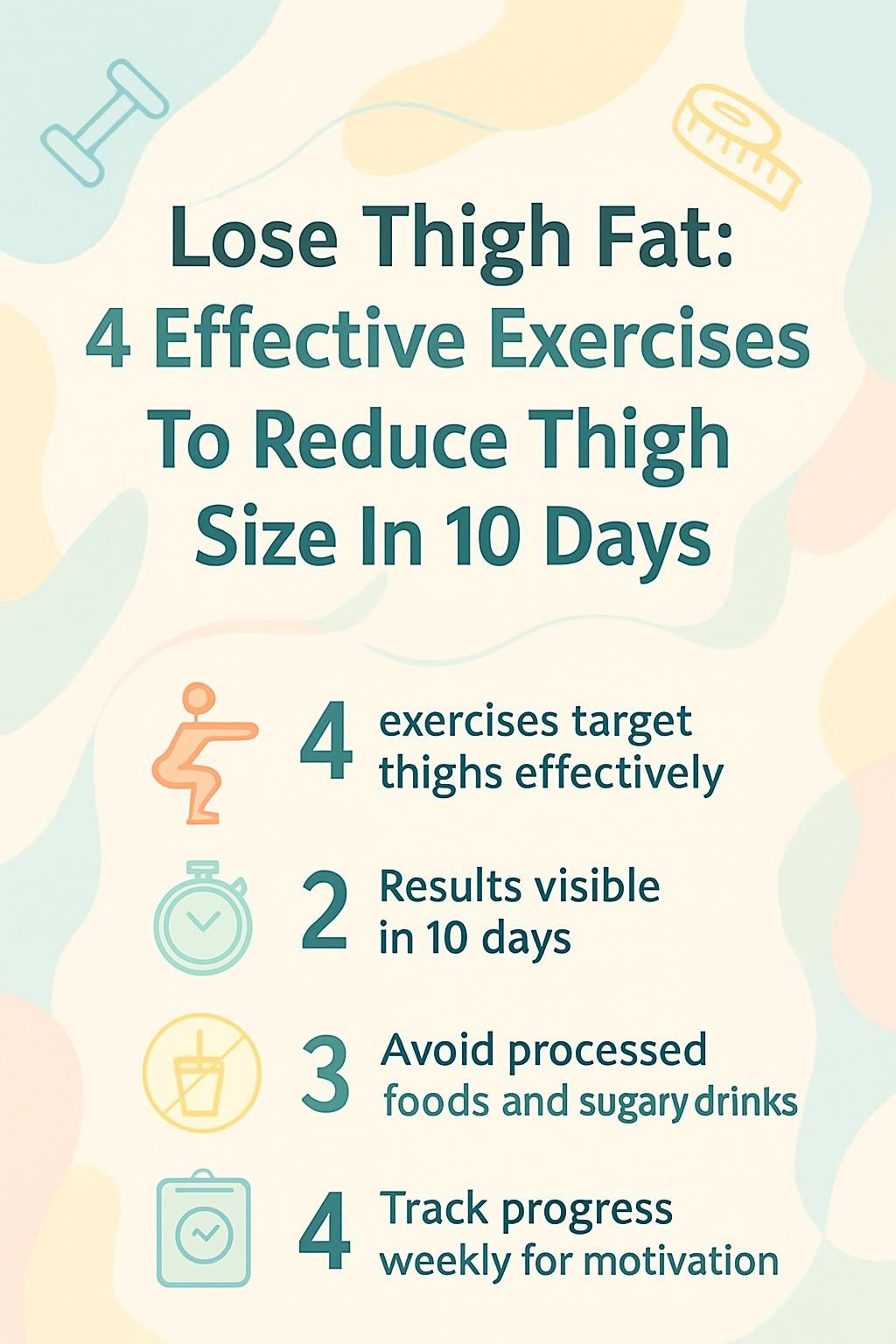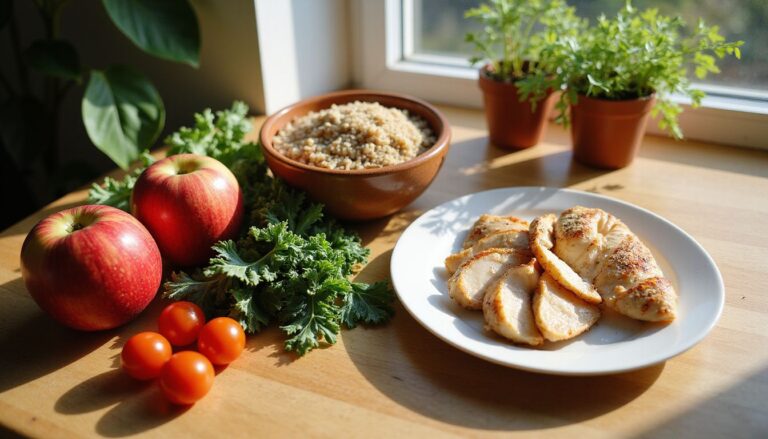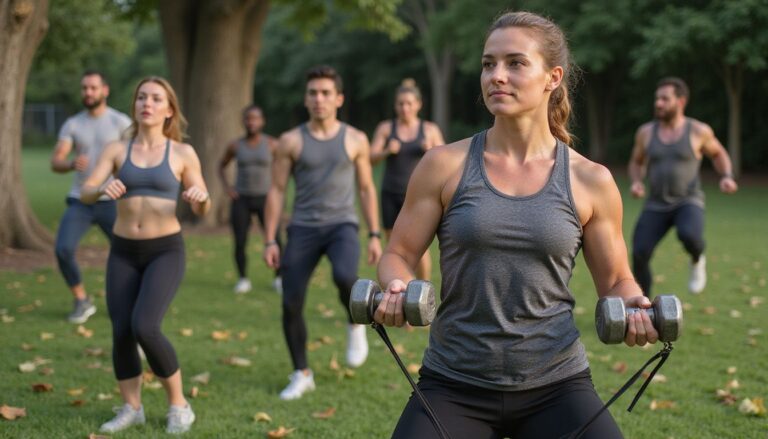Lose Thigh Fat: 4 Effective Exercises To Reduce Thigh Size In 10 Days
Our Nutrition Assistant AI Suite will transform your body. You will lose fat, get toned, and build muscle. Gain confidence and optimal health.
Thigh fat can feel stubborn, even if you exercise often. Genetics, hormones like estrogen, and daily habits all shape how your body stores fat in the lower body. Creating a steady calorie deficit, which means eating fewer calories than you burn, helps you lose thigh fat and keep it off.
This guide shows four simple moves to tone and strengthen your legs while you burn more calories each day. You will also get diet tips and habit changes for steady progress. Use these steps to reduce thigh size in 10 days, then keep building from there.
Discover the moves that can help shrink your thighs in just 10 days!
Key Takeaways
- Creating a daily calorie deficit through balanced meals and exercise, as the CDC recommends, helps reduce body fat, including persistent thigh fat.
- Four key exercises, sumo squats, forward lunges, side lunges, and jumping jacks, tone thigh muscles and increase calorie burn for visible results in as little as 10 days.
- Genetics and hormones like estrogen, especially in females, contribute to thigh fat accumulation and may slow progress despite consistent workouts and healthy eating.
- Processed foods, sugary drinks, and high-salt diets increase fat and water retention in thighs, so focus on whole foods, lean protein, and hydration for fat loss.
- Tracking thigh circumference, exercise routines, and dietary habits weekly helps monitor progress and supports motivation for realistic and sustainable fat loss goals.

Causes and Contributors of Thigh Fat

Thigh fat builds up for several reasons. Food choices, activity levels, genetics, and hormones all play a part. Your body may favor storing extra energy as fat in the thigh area, especially if estrogen levels are higher.
What factors cause fat to build up on the thighs?
Excess weight raises the chance of more fat on your thighs. Estrogen, a key sex hormone, often directs more storage around the hips and thighs in females. High-salt meals can cause water retention, which inflates thigh measurements.
Processed foods high in sugar and unhealthy fats add calories quickly and raise total body fat. As people age, metabolism usually slows, which makes fat loss harder and progress slower.
Cellulite may appear along with thigh fat. It looks like dimples or ripples because connective tissue pulls down while fat pushes up under the skin.
Over 42% of American adults were classified as obese in 2020, which raises the risk of thigh fat buildup. (CDC, 2020)
Eating more calories than you use encourages fat storage in the thigh area. Low physical fitness reduces muscle, and less muscle means fewer calories burned at rest.
Some medical issues, such as lymphedema and lipedema, can cause swelling or abnormal fat buildup in the legs and thighs. Family history also matters, since genes affect how and where fat cells grow. If you notice ongoing pain, swelling, or lumpy skin, speak with a healthcare professional.
How do genetics and hormones affect thigh fat?
Genetics strongly influence fat storage. Some people inherit a higher chance of carrying extra weight on the inner thighs and outer thighs. The look of cellulite also relates to genetics because connective tissue structure differs from person to person.
Hormones guide where fat goes. Estrogen increases subcutaneous fat storage, the fat just beneath the skin, in the thighs and glutes. Puberty, pregnancy, and menopause all shift hormone levels, and thigh size can change with those shifts.
Hormonal imbalances can lead to more water retention and more energy stored as fat. Age-related changes often make thigh fat more noticeable. Up next, see how a steady calorie deficit supports fat loss in 10 days.
Combining Diet and Exercise for Thigh Reduction
To slim your thighs, pair smart eating with regular training. Diet creates the calorie deficit, and exercise keeps leg muscles strong and defined.
How does creating a calorie deficit help reduce thigh fat?
You reduce thigh fat by using more energy than you eat. This gap is a calorie deficit. The Centers for Disease Control and Prevention suggests losing about 1 to 2 pounds per week for safe progress.
Aim for a mix of healthy meals, cardio like brisk walking or HIIT, and strength moves such as squats and lunges. Spot reduction does not work, so target total fat loss. Many fitness experts say,
“Consistent calorie deficits help reduce overall body fat including stubborn areas like the thighs.”
Tracking your intake and activity helps you notice early changes around the legs within a couple of weeks.
What eating habits can slim down your thighs?
Food choices drive progress. Build meals that support muscle, steady energy, and total fat loss.
- Eat more fruits, vegetables, and lean proteins at each meal to boost nutrients and control calories.
- Choose whole grains instead of refined grains to steady blood sugar and improve workout endurance.
- Limit processed foods and alcohol, which add empty calories and raise body mass index.
- Drink water before meals to reduce hunger and support metabolism through diet-induced thermogenesis.
- Swap salty snacks for fresh options like nuts or fruit to reduce bloating in the thighs.
- Pick eggs or Greek yogurt for breakfast to raise protein, which supports quadriceps and hamstrings.
- Read labels to avoid added sugars, since high sugar intake promotes more stored fat on the body.
- Avoid extreme diets that cut whole food groups or slash calories. These lower resting metabolic rate and slow fat loss.
Simple meal patterns and steady portions help you stay consistent. Consistency matters more than perfection.
Top Exercises to Reduce Thigh Size Quickly
Targeted moves shape the legs while total activity burns fat. Short, focused sets build strong muscles that support a leaner look.
How do sumo squats tone and strengthen thighs?
Sumo squats use a wide stance to hit inner thighs and outer thighs. The glutes and hips also work hard in each rep. Try 25 reps twice per day, which totals 50 reps, to build definition and support fat loss.
Using body weight is enough at first. Later, add dumbbells for more challenge. Keep your chest lifted, knees tracking over toes, and core braced. After two weeks of consistent work, many people feel firmer thighs and see better muscle tone.
What are the benefits of forward lunges for thigh sculpting?
Forward lunges train the front thigh muscles, hamstrings, and glutes in one step. This move challenges balance and helps shape the legs while you burn calories.
Perform 15 reps per leg and complete 3 rounds. You can use just body weight or hold light weights. Two days of resistance training per week that includes lunges supports fat loss and strength. Pairing lunges with jogging or indoor cycling can increase total calorie burn.
How do side lunges target inner and outer thighs?
Side lunges build strength as you step out and sit back. This action activates the inner thigh adductors and the outer thigh abductors.
Complete 15 reps per side for 3 rounds. Add dumbbells or a resistance band for more intensity. Side lunges also improve hip mobility, which helps with daily movement and lowers injury risk during other workouts.
Why are jumping jacks effective for cardio and fat burning?
Jumping jacks raise your heart rate fast and work many muscles at once. Legs, arms, and core move together, which increases calorie burn.
They require no equipment, so you can do them anywhere. Cardio like jumping jacks helps reduce body fat when paired with a calorie deficit. Short intervals can fit into HIIT sessions for extra burn in less time.
Additional Workouts to Enhance Thigh Fat Loss
Mixing workouts keeps training fresh and increases your chance of steady fat loss. Think of these as add-ons to your core routine.
How do burpees boost high-intensity fat burning?
Burpees combine a squat, plank, and jump into one powerful move. They tax your thighs, glutes, core, chest, and arms while spiking your heart rate.
As part of HIIT, burpees create a strong afterburn effect, which means you keep burning calories after the session. No equipment is needed, and performance improves with practice. Many athletes use short burpee intervals to build endurance and increase daily energy use.
Can air cycling help burn thigh fat?
Pairing burpees with air cycling gives your thighs focused time under tension. Lie on your back, lift your legs, and pedal in the air. This works the thighs, hip flexors, and core with low impact.
Air cycling fits all fitness levels and can be done at home. Consistent sets help tone the legs while supporting a calorie deficit. After several sessions, many people notice stronger inner thighs and better endurance.
What are the benefits of stair climbing for strength and calorie burn?
Stair climbing strengthens thighs and glutes while burning calories quickly. A 154-pound person can burn roughly 295 calories climbing for 30 minutes, and about 590 calories in an hour.
Each step targets the lower body and improves balance. Stairs are easy to find, which makes this habit simple to keep. If you wish to avoid procedures like liposuction or thigh lifts, stair sessions help reduce fat while building functional strength.
Cardio Workouts for Reducing Thigh Fat
Cardio creates a reliable calorie deficit, which supports fat loss. Blend short, intense sessions with steady efforts for the best mix.
What are the benefits of High-Intensity Interval Training (HIIT)?
HIIT uses short bursts of hard work with brief rests. Examples include jump squats and burpees. This approach raises your heart rate fast, then keeps calorie burn elevated after the workout ends.
Including leg-focused moves helps tone your thighs while you lose fat. Many experts suggest doing HIIT two or three times per week, which aligns with CDC activity guidance.
How does steady-state cardio support consistent fat loss?
Steady-state cardio means moving at a moderate pace for a longer time. Brisk walking, cycling, or swimming are common options. The CDC recommends at least 150 minutes each week for health and weight control.
This style is joint friendly, which helps if you are overweight or have arthritis. It builds a steady calorie deficit without high impact. Track your steps or heart rate to stay consistent. Many lifters pair steady cardio with squats or leg presses for balanced results.
Strength Training for Leaner Thighs
More lean muscle raises your resting calorie burn. Strong leg muscles support a toned look and make fat regain less likely.
How does lean muscle building increase calorie burn?
Muscle tissue burns more energy than fat, even at rest. When you add muscle, your resting metabolic rate increases. A systematic review shows that resistance training boosts calorie burn for hours after a session.
Exercises like lunges and squats help you maintain a lower body fat percentage over time. More muscle supports a leaner shape and steadier weight control.
What resistance training strategies are best for beginners?
Start simple and focus on form. These steps help you build strength safely and see progress.
- Start with bodyweight moves such as squats, lunges, wall sits, and step-ups.
- Do 15 reps per set for 3 rounds to build volume and control.
- Use both two-leg moves and single-leg moves like split squats to improve balance.
- Mix upper and lower body exercises for a full-body routine that burns more calories.
- Begin with two strength sessions each week so your muscles adapt.
- Increase resistance slowly, adding light weights after you master technique.
- Keep proper form during every rep to avoid injury as you lunge to slim and try new tools.
- Rest between sessions to support recovery and steady thigh fat reduction.
- Track changes with simple measurements or photos to see progress clearly.
Lifestyle Adjustments for Better Thigh Fat Loss
Small daily habits support fat loss. Hydration, stress control, and sleep help your body use energy well.
How does hydration aid fat metabolism?
Drinking enough water helps your body break down stored fat, a process called lipolysis. A glass of water before meals can reduce hunger and calorie intake. Good hydration also limits water retention and bloating in the thighs.
Choosing water instead of sugary drinks cuts liquid calories and supports a calorie deficit. Hydration improves workout performance since muscles work better when fluids are balanced.
| Benefit | Explanation |
|---|---|
| Supports fat metabolism | Water helps break down stored fats for energy |
| Reduces water retention | Less bloating makes thighs look slimmer |
| Controls appetite | Drinking before meals can lower calorie intake |
| Improves exercise performance | Hydrated muscles contract more efficiently |
| Cuts liquid calories | Replacing soda with water reduces daily calories |
| Helps remove waste | Kidneys clear byproducts created during fat loss |
A friend of mine swapped soda for water for two weeks. Her cravings dropped, and her legs felt lighter during daily walks.
Why are stress and sleep management important for fat loss?
Chronic stress can raise cortisol, a hormone that pushes hunger and cravings. That pattern makes it hard to keep a calorie deficit. Poor sleep slows metabolism, lowers energy for workouts, and delays recovery.
Seven to nine hours of quality sleep supports normal hormone function and fat burning. Managing stress helps you show up for workouts and stick with your plan. Small routines, such as a consistent bedtime and short breathing breaks, can help a lot.
What processed foods and drinks should be avoided?
Some items work against thigh fat loss. They add hidden calories, sugar, and salt.
- Fast food often contains trans fats, lots of salt, and refined carbs. Many meals exceed 1,000 calories.
- Packaged snacks like chips and cookies usually include added sugars and additives that drive overeating.
- Sugary drinks, including soda and sweet teas, add empty calories. A 16 ounce soda can hold about 44 grams of sugar.
- Alcohol adds calories and slows fat metabolism, making stubborn thigh fat harder to lose.
- White breads, pastries, and low fiber cereals replace nutrients with fast-digesting starch.
- Frozen dinners can be very salty, which increases bloating. Some contain more than 800 milligrams of sodium.
- Candy bars deliver large amounts of added sugar in small servings, which raises total calorie intake.
I replaced soda with water for two weeks and noticed looser jeans at the thighs. Less bloating and fewer liquid calories made a clear difference.
Debunking Myths About Thigh Fat Reduction
Smart progress comes from facts, not myths. Clearing up the confusion helps you focus on what works.
Is spot reduction of thigh fat possible?
Spot reduction is not supported by research. Your body decides where fat leaves first, which depends on genetics and hormones. Leg exercises strengthen muscles under the skin, but they do not pull fat from that exact area alone.
A 2013 study in the Journal of Strength and Conditioning Research found that training a single muscle group did not increase fat loss in that specific area. Use a calorie deficit, full-body training, and steady habits to change thigh size.
Why don’t quick fixes work for lasting fat loss?
Crash diets and extreme cuts lead to fast scale changes, but much of that is water or muscle. The CDC recommends losing 1 to 2 pounds per week to keep results.
Harsh methods often slow metabolism and are difficult to maintain. Once old habits return, weight usually comes back. Balanced meals, safe exercise, and steady routines deliver results that last.
Setting Achievable Thigh Fat Loss Goals
Clear goals keep you focused. Small steps repeated daily drive change that sticks.
Why are consistency and patience key to losing thigh fat?
Daily effort builds habits that burn thigh fat and prevent stalls. Body composition changes slowly, and weight can shift day to day from water or muscle gain.
Watch the trend across 10 days and beyond. Patience lowers frustration and keeps you moving forward. Routine workouts and consistent eating make fat loss possible, and patience helps you reach a leaner lower body.
How can you effectively track your thigh fat loss progress?
Tracking helps you see what works and stay motivated. Use simple tools to measure change.
- Measure thigh circumference at the widest point weekly and log it.
- Take photos from the front, side, and back on days 1, 5, and 10.
- Track workouts, including frequency, intensity, and exercise types such as sumo squats or jumping jacks.
- Record body weight and body composition if you have access to a smart scale.
- Note fitness gains, like more lunge reps or longer squat holds.
- Log meals each day and mark any changes that affect progress.
- Set short 10-day goals and longer goals, then celebrate milestones.
- Notice non-scale wins, like better-fitting pants or stronger legs on stairs.
Conclusion
Losing thigh fat requires a plan and steady action. Create a calorie deficit with balanced meals, then train your legs with sumo squats, lunges, side lunges, and jumping jacks. These moves tone your thigh muscles while you burn calories.
Hydration and quality sleep speed recovery and support fat loss. Cut processed foods and sugary drinks to reduce bloat and extra calories. Track measurements and photos to see progress clearly and to reduce thigh size in 10 days or more.
This article is for education and does not replace medical advice. If you have symptoms like ongoing swelling or pain, consult a qualified healthcare professional. Sources for guidance include the CDC on safe weight loss and peer reviewed research on spot reduction and resistance training.
FAQs
1. What are the most effective exercises to reduce thigh size in 10 days?
Squats, lunges, step-ups, and wall sits target major leg muscles and help burn calories. These movements engage both quadriceps and hamstrings, which can support fat loss when combined with a calorie-controlled diet. Studies show that regular lower-body workouts increase muscle tone and metabolic rate.
2. Can spot reduction help lose fat only from thighs?
Current research shows that targeted fat loss from a single area is not possible through exercise alone. Whole-body fat loss occurs when you burn more calories than you consume. Thigh-focused workouts will strengthen and shape your legs but must be paired with overall fat reduction strategies for visible results.
3. How many repetitions should I perform for each exercise daily?
Performing three sets of 12 to 15 repetitions per exercise, five times a week, can yield noticeable changes. Consistency is key; combining these workouts with aerobic activity like brisk walking or cycling enhances calorie expenditure and supports faster progress.
4. Is it realistic to expect significant thigh size reduction in just 10 days?
Rapid changes in body composition are uncommon within ten days according to clinical studies. While you may notice improved muscle definition and reduced bloating from increased activity and healthier eating, substantial fat loss typically requires several weeks of sustained effort.
Summary:
Effective thigh-slimming involves squats, lunges, step-ups, and wall sits performed regularly alongside a balanced diet. Spot reduction does not work; whole-body fat loss is necessary for slimmer thighs. Aim for three sets of 12-15 reps per move on most days. Noticeable results often take longer than ten days but starting now builds healthy habits for lasting change.







